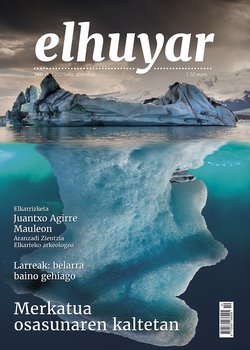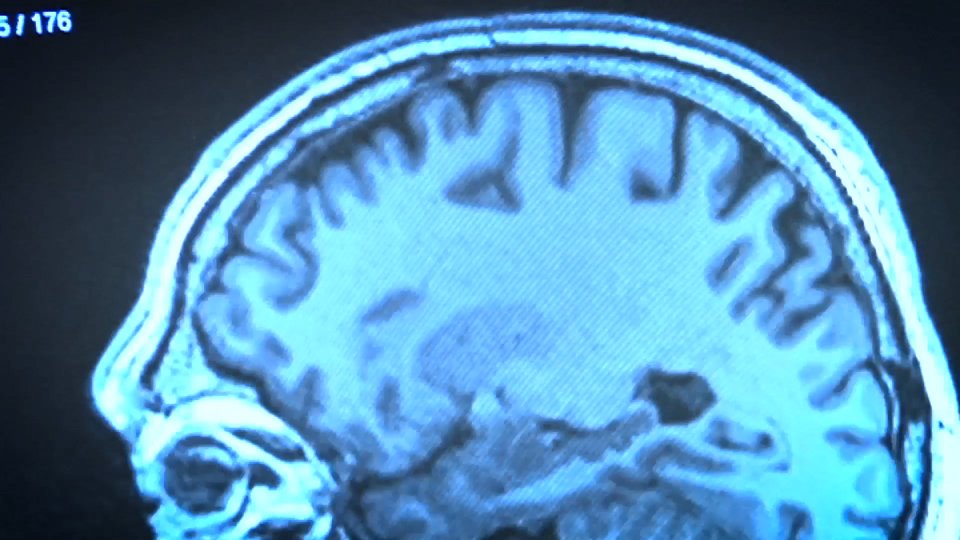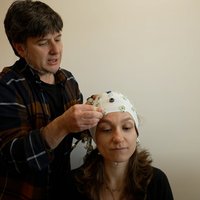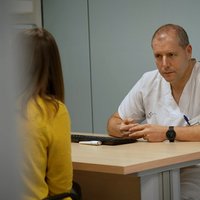Ana Mª Cobo: Apparently, the mutation causes the disease arose here
With the help of researchers from Iparralde, France and Catalonia, they have discovered the mutation and its consequences, as well as where and when the mutation occurred. Amets Saenz continues to delve into the research, but is now in Canada and his research friend, Ana Mª Cobo, has explained the details of the research.

What diseases have you studied?
We investigated muscular lumbar dystrophy. This disease affects the muscles of the pelvic and scapular waist, so the muscles of the upper and lower extremity weaken. Finally, the patient ends up in a wheelchair.
However, there are different types of lumbar muscular dystrophies, some more severe and some lighter. In fact, 150 different mutations of the same gene could produce lumbar muscular dystrophy. We have focused on a single type of dystrophy, the LGMD2A, more common in the Basque Country than in any other country. This type of dystrophy is due to a specific mutation of the gene and is a serious disease.
On the other hand, superative lumbar dystrophies and recessive dystrophies are distinguished. In the former, it is enough for a parent to have the mutated gene for their children to develop the disease. This dystrophy that we have in Euskal Herria, on the contrary, is a recital, which means that both the father and the mother of those who suffer the disease must be mutated.
What is that gene and why does
the disease cause if it is mutated?
The gene is calpain3. When the gene is fine, it is expressed and the protein that is produced is a chaff. This protein is an enzyme that is anywhere, one of its forms is muscle. Well, those who have mutated the gene that encodes this muscle enzyme are those who develop it.

This is because a mutation either does not generate any pipe, or what is generated is defective. The gene consists of twenty-four parts, a mutation that occurs in the twenty-second. One of them might think that, being well from one to twenty-one, almost all the protein will be formed and that, more or less, it should be able to perform the function. However, it is not so, but the resulting defective protein degrades quickly. Therefore, if we do a dye to check if there is protein or not, we will not see any traces of it.
What are the consequences of lack of protein? What are the symptoms?
Lack of protein causes severe lumbar muscular dystrophy. When other mutations occur in the gene, protein is sometimes formed. This protein may not be able to do the function, but the dystrophy that appears is not entirely serious. On the contrary, if the mutation produces a lack of protein, then it is very serious. And that's our case.
The disease begins to be noticed as a child. They are clumsy children, little skillful walking, running and often falling. Clear symptoms appear at age 8-15. For example, they behave like ducks, balancing, as the muscles of the pelvic and scapular waist have no strength.
It mainly affects the muscles near the waist, the bottom. Thus, it affects more than the twins to the back of the buttocks and thighs. If, while sitting on the ground, he asks a patient to get up, he will not be able to get up without more; with his hands leaning on his knees he will rise slowly with force. And in the upper waist, equal; in the muscles closest to the shoulder more weakness is appreciated, especially in the back. However, it hardly affects the muscles of the face, they do not usually have the face fall.
However, it is a progressive disease that, as it progresses, worsens the situation of the patient. To turn 20, almost all patients are in a wheelchair. In addition, when the disease is advanced, they usually have breathing problems as the chest muscles weaken.
And is there no effective remedy or treatment?
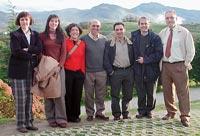
No, it cannot be cured. As for treatments, I am not a doctor, but I think they now give them corticosteroids. Although some palliative treatments are being tested, there is no alternative at the moment.
In the future it may be gene therapy. Gene therapy involves replacing the mutated gene with a healthy gene to produce the protein properly. However, gene therapy is in its beginnings and we do not know how much it will progress, nor if we can use it to cure this type of disease.
How is it diagnosed?
Amets, the friend who researched with me, now works with a microchip. They introduce into the chip the most common mutations in a family and just put a drop of blood to make the diagnosis. I don't know how far this research is advanced.
At the moment, the diagnosis is clinical, that is, highlighting the symptoms it is known that a patient has developed the disease. Subsequently, the suspected molecular study is verified.
You
mentioned earlier that here there are more sick than anywhere else...
Yes, it is. It is a very rare disease in the world, but we realized that in Euskal Herria there were more cases than anywhere else, especially in an area of Gipuzkoa.
The truth is that neurologist López de Munain had patients who wanted to know what diseases they had and what caused them. They then contacted the French association of neuromuscular diseases. And they also had these cases.
In addition, this association raises enough money through television marathons and devotes part to research. As they found it interesting, they decided to promote this study. Pediatrician Jon Andoni Urtizberea was one of the most helpful.
So did French patients also participate in the research?
Yes. The French association sent us samples of different patients, most of them from Iparralde. We gathered the sick of Gipuzkoa in hospitals and health centers in the province. In addition, seeing that in the island of Reunion there were many cases, we also obtained samples of the patients present there. Whenever possible, blood samples were collected from parents and in all cases the origin of the sick was taken into account. And we wanted to see if there were differences between patients from Euskal Herria and those from outside. A total of 65 patients with the same mutation were collected.
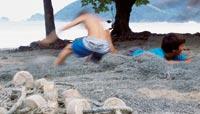
They are often clumsy children, many times they fall and don't run well.
Most Basque patients had this specific mutation in gene 3, in recessive form. In patients from other backgrounds, however, there were more variants, there were more confusion. In Gipuzkoa, on the contrary, almost all were of this type.
First we conducted a prevalence study, that is, we calculated the percentage of patients over the total population. And there we clearly saw that in Gipuzkoa it is more common than anywhere else. Thus, in Gipuzkoa there were 67 patients per million inhabitants. Then, surprisingly, is the island of Reunion, with 48 patients per million inhabitants. On the other hand, as we move away from Gipuzkoa there are still cases, but to put it in some way the disease is diluted. Therefore, the closer geographically to Gipuzkoa, the greater the prevalence and vice versa.
In your opinion, the result was significant, right?
Yes, of course. More if we consider that the highest prevalence occurs in isolated areas of Gipuzkoa, specifically in the regions of Urola Kosta and Bajo Deba. In our opinion, this suggests that the mutation arose there, and it is no wonder that now there are so many cases, knowing that until recently its inhabitants have hardly mixed with those outside. Without a doubt, orography has greatly influenced this. In addition, due to the Catholic tradition, parents had many children and mortality was not very high. All this explains that the prevalence is so high.

At this point in the research we came up with another question: When was the mutation? Perhaps it was very old, it occurred to us that it could be from the Palaeolithic. But at the Universitat Pompeu Fabra in Barcelona they did the calculation and… it did not give the expected result.
When is the mutation?
He is quite young, about a thousand years ago. And that was a surprise to us. In fact, similar
cases have occurred in other isolated populations, but in them the mutation was older. This mutation arose yesterday, only fifty generations ago.
And yet it has had time to proliferate so much, and not only that, but to go abroad: look at the cases of the island of Reunion, Martinique, Madeira and Brazil. In all these places we have found sick and it is very likely that among their ancestors there is some Basque who has approached there. Probably the XVI. Behind it are hidden those great cruises of the nineteenth and twentieth centuries, but we can not demonstrate all this.
However, we have managed to demonstrate well what causes the disease, what is the gene, what mutation, when it arose... It has been a complicated but beautiful job, and we have received a reward because we have been given several awards for our work. But we are clear that we could not move forward if we hadn't received so much help. Collaboration has been instrumental in carrying out this research.
Calculating age of mutations
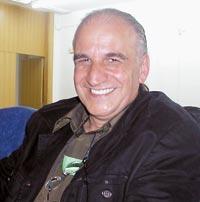
To know when the distrofiative mutation occurred, the researchers were assisted by the Pompeu Fabra University of Barcelona. We also went to Jaume Bertranpetit university professor to learn how they calculate the age of a mutation.
Bertranpetite explains that the mutation process works like a clock. In fact, mutations occur at a certain frequency, allowing you to know when a mutation has remained.
To calculate the age of a mutation it is necessary to know what has been moved. Not all parts of the genome move as often.
If the mutation causes disease, it is quite easy to retreat. In the words of Bertranpetit, it should be noted
that all patients have the same anchor, they come from what remained the mutation. “Given the nature of the mutation and the frequency with which the adjacent parts have changed, we calculate when the mutation has occurred.”
Buletina
Bidali zure helbide elektronikoa eta jaso asteroko buletina zure sarrera-ontzian


